Cittern chap book:
To the Proficient Scholler or Lover of the Cittharn. . .
The "Renaissance" cittern of 16th and 17th century Europe is my favorite instrument, both to make, as a luthier, and to play.
It is a delightful, light, wire-strung instrument that has a substantial solo repertory, as well as being a staple of the broken consort. Its sound when used in continuo is plucky and rhythmic, sounding in range from the cluck of an Appalachian banjo to the marching calculation of the harpsichord. When heard alone, it defies comparison to any other instrument: an unmistakable sound.
The following is a summery of my work with the instrument.
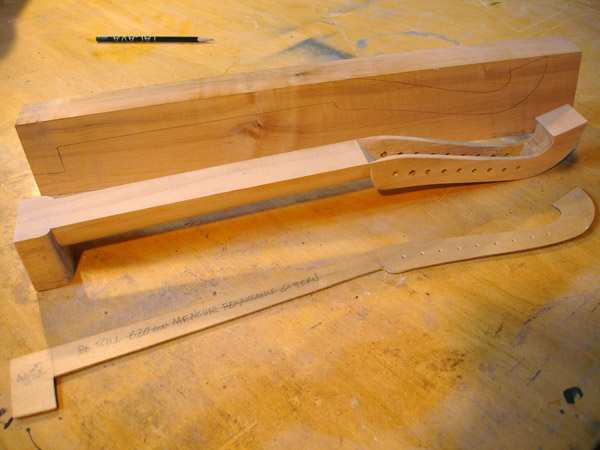
Stages of the tenor cittern neck/pegbox. My own pattern based on historical shapes.
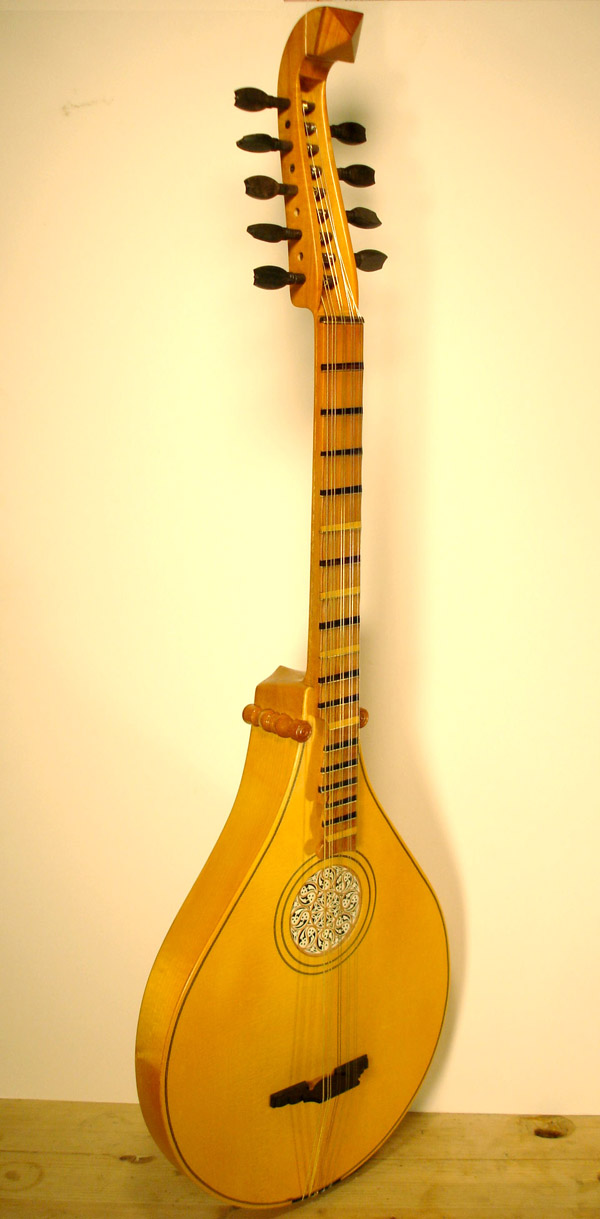
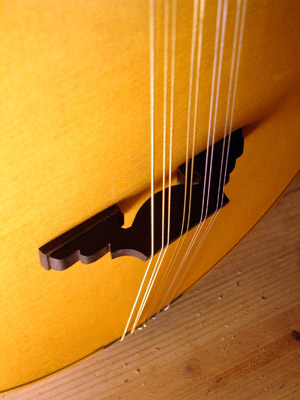
A Tenor Renaissance cittern, 61.6cm mensur.
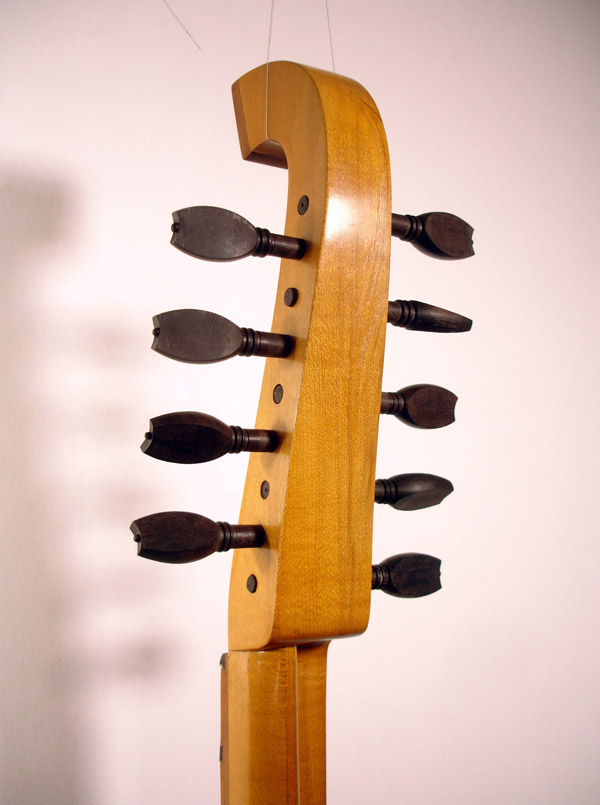
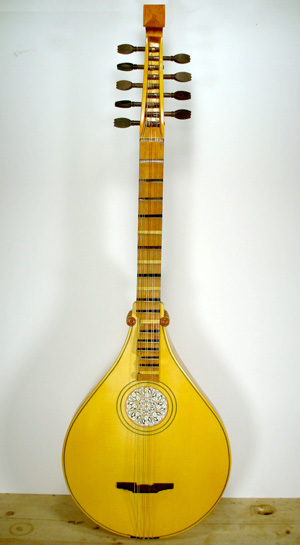
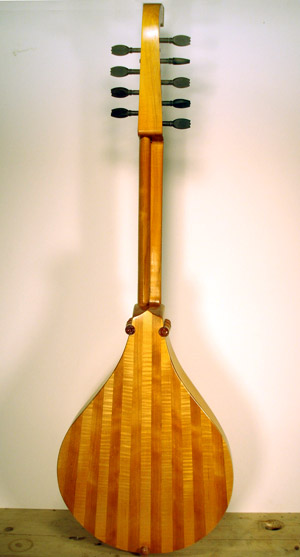
A Tenor Renaissance cittern with striped maple and cherry back, cherry fingerboard with ebony and boxwood fret wedges, ebony pegs and bridge and a 2-layer parchment and pearwood rosette by Elena Del Cortivo of Milan.
My first tenor cittern with a non-historic rosette.
The pegbox of a Tenor model cittern, 61.6cm mensur. I have had some success recently experimenting with different tunings on this instrument. For years I played it tuned just a whole step below the typical 'Italian' tuning - quite high for a tenor size instrument - and it was very loud and plucky and delightfully well intonated, so I left well enough alone! - but in light of some recent inquiries, I have tuned the instrument down a 4th from there to f#-f#/d-d'-d/a-a/b-b, but without changing the strings. Thus taking it down into the range of a modern cittern tuning. I am happy to report that the intonation is not compromised and the sound is still penetrating. To hear samples of the instrument at this tuning click:
Example 1 (playing near the bridge)
Example 3 (playing closer to the rose)
The following is a short video of me playing a hep version of 'Light of Love' in F-C-f-c-f' tuning. If Roger McGuinn played the renaissance cittern I would like to think it would sound something like this:
And since the sound is terrible on my little digital camera, here's a sound clip made with actual recording equipment:
'Light of Love' on 5-course F-cC-fF-cc-ff tuning
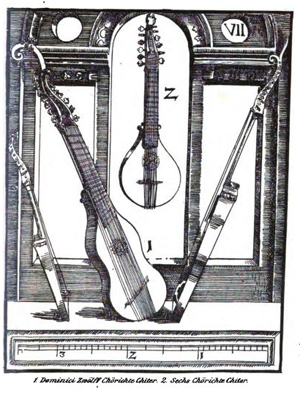
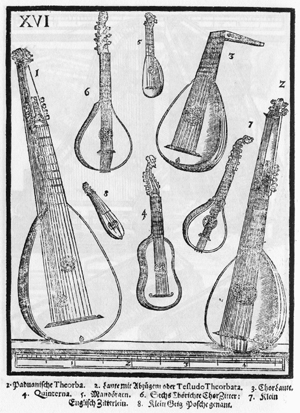
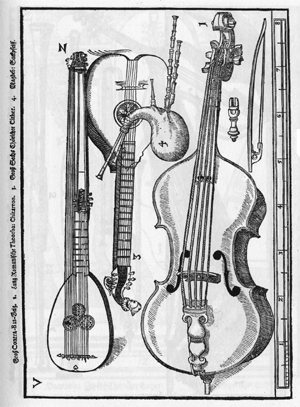
Praetorius has not one but three plates depicting citterns. Plate VII shows two in side profile, the one on the right having a bass extension. Also in this plate is a guitar-shaped orpharion. Plate XVI shows an early continental style with occipital pegs (6) and a cittern which he describes as 'English' (7). Plate V has an atypical body shape hidden behind a bagpipe.

The ubiquitous Robinson engraving shewing the positions of the frets
Detail of the scroll covers of the Tenor.
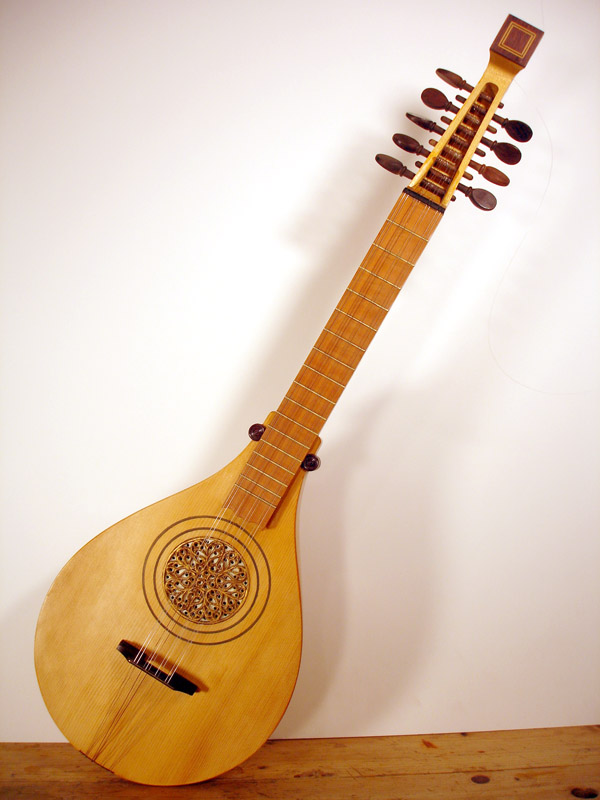
A version of the Ashmolean DaSalo, styled after the Early Music Shop (Bradford) kit, strung in four courses bb-GgG-dd-ee. Pearwood fingerboard, maple costructed-type body, carved neck/pegbox, striped cherry back, rosewood pegs and scrolls, brass frets with scalloped fingerboard and ebony bridge with brass saddle. Link to video of me playing this instrument. EMS has offered this instrument as a simplification of the Ashmolean instrument since the early 1980's. I got my first kit from them in 1988 and have since put together a friend's kit and built several other instruments of nearly the same specifications by making templates from the original kit parts. I'm finally getting away from copying this instrument however, now that I've inspected the original in the Ashmolean.
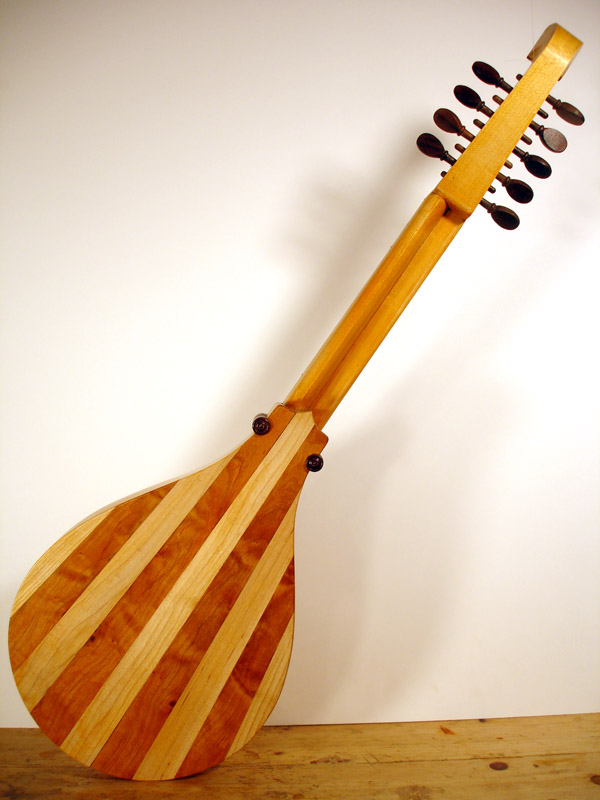
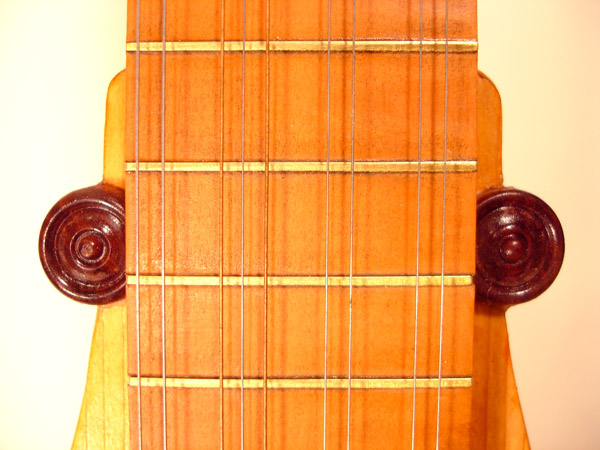
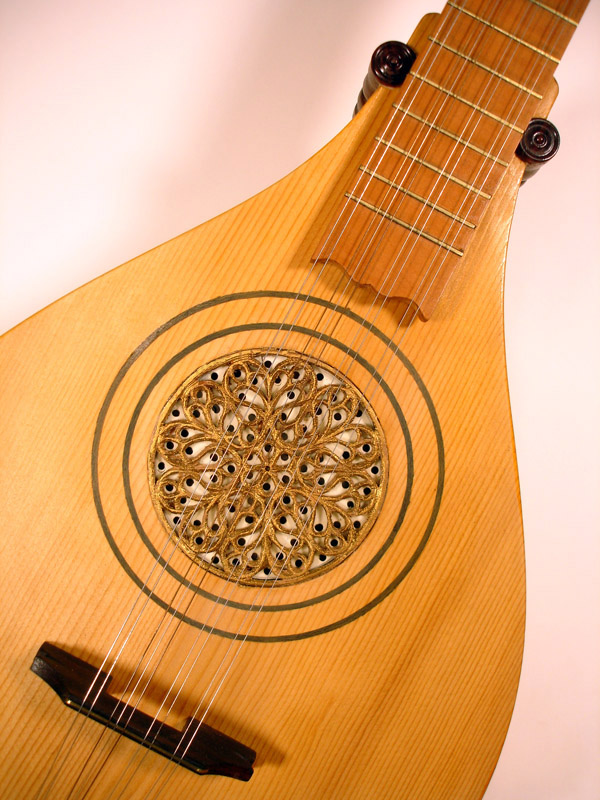
The gothic rosette of the EMS kit is not the rosette of the original instrument, which is quite different (see my study images below)
+++++
Process photos of various DaSalo models
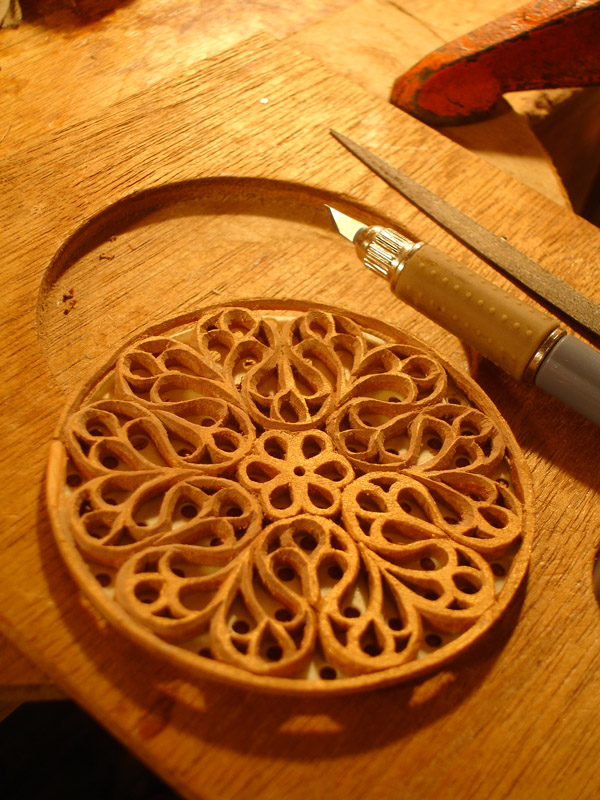
Carving the pearwood rosette after piercing with the jeweler's saw.
+++++
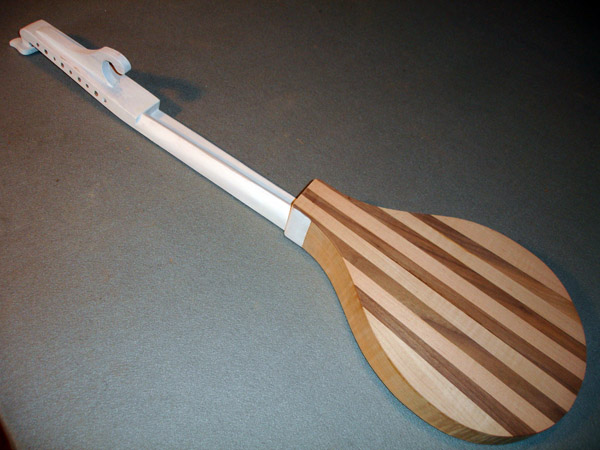
I call this my 'constructed neck' cittern. After carving endless thumb channels and pegboxes out of one solid piece of wood I have contrived to build this unwieldly shape out of an assembly of easily planed and joined pieces of wood. Besides being held together entirely by glue, the only design liability I have found is it is less condusive to gently curving pegboxes (however the Ashmolean DaSalo is straight), and the pointed heel has been replaced with a less elegant 'flat'. However on the other side of the coin, it took me about 4 hours to make the entire neck and pegbox. And after I gesso it and paint it black you'll never know.
.jpg)
Showing the components. Note the hook is laminated to prevent future destruction. The seams of the 'cheeks' and 'blocks' are clearly visible.
.jpg)
.jpg)
.jpg)
.jpg)
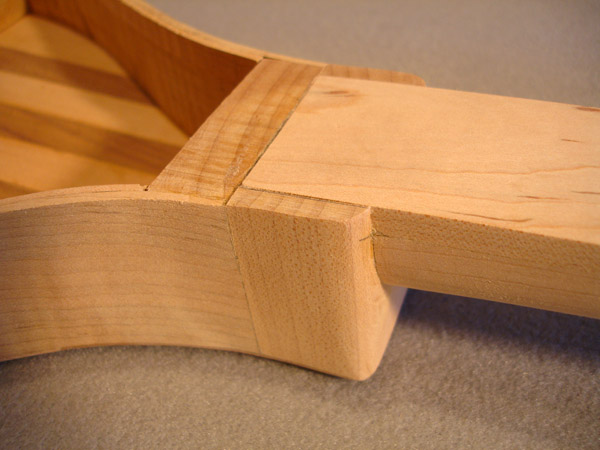
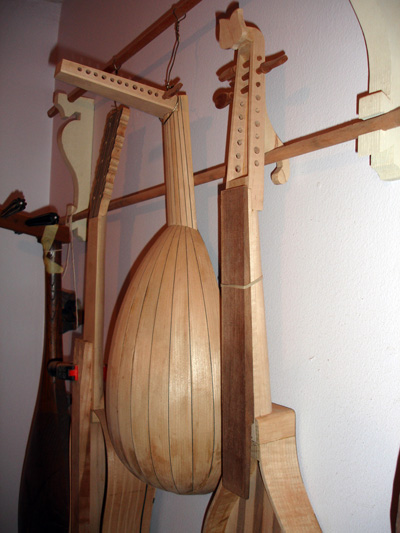
Hanging around with a friend.
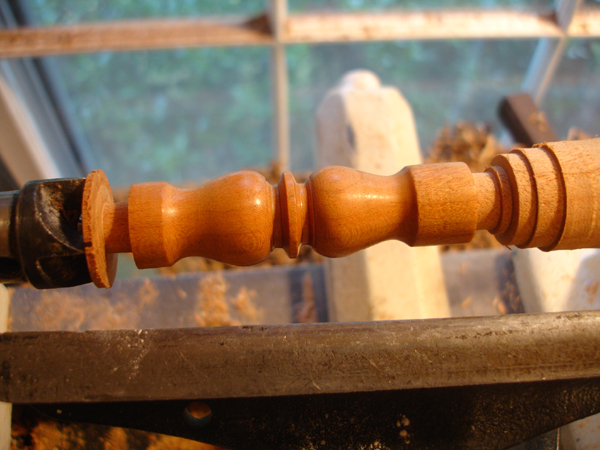
Turning the scroll for a tenor out of cherry. This is the Ashmolean shape.
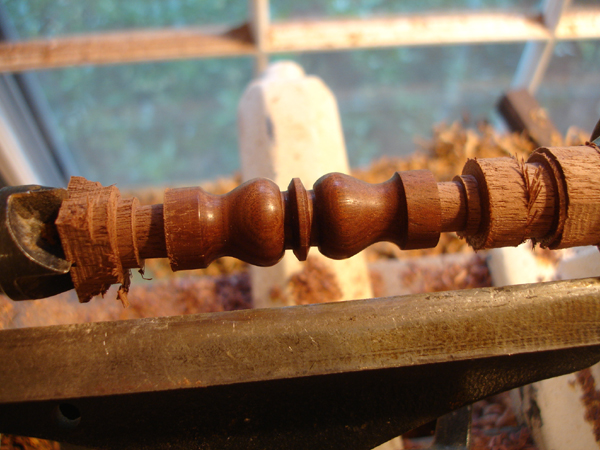
The same design in walnut sized for the standard instrument
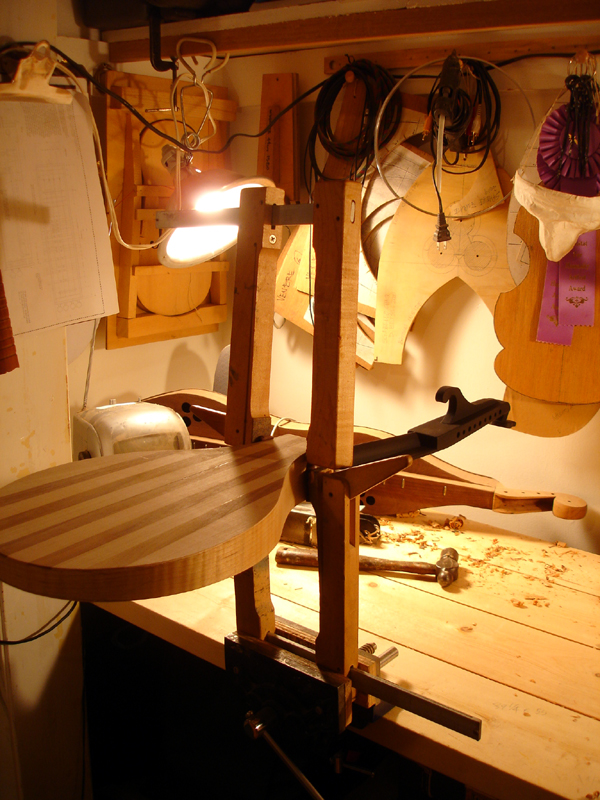
And this trapeze act is the gluing on of the scrolls. Note at this point the neck/pegbox of the constructed cittern is painted.
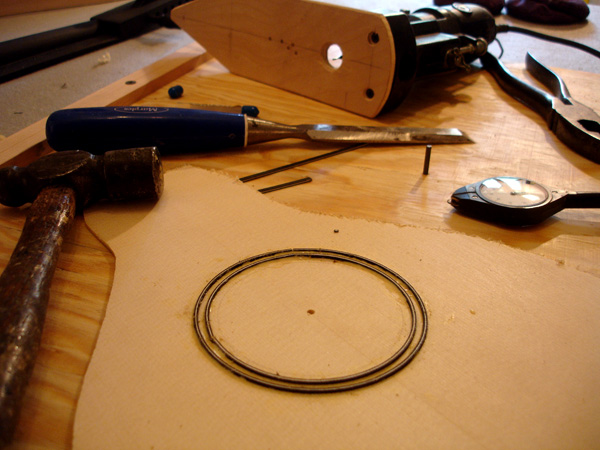
Question: If Stradivarius had a spiral downcut purfling cutter, would he use it? Answer: yes.
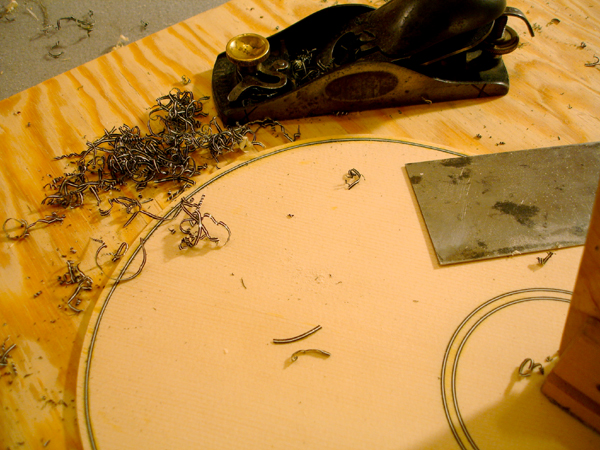
I usually put two rows of purfling around the rose and one around the edge. The Ashmolean has two around the edge and none around the rose.
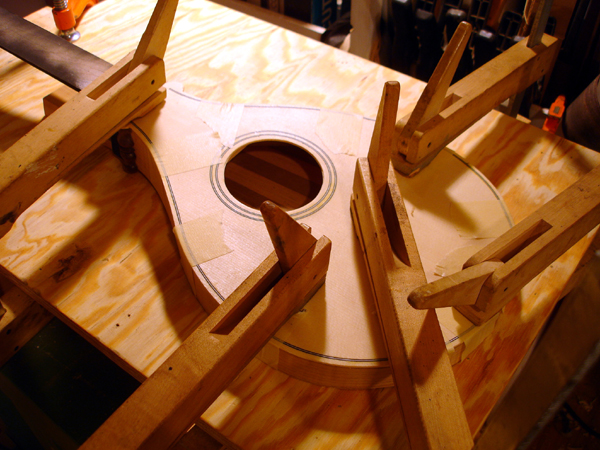
The constructed neck cittern gets the top and braces attached concurrently.
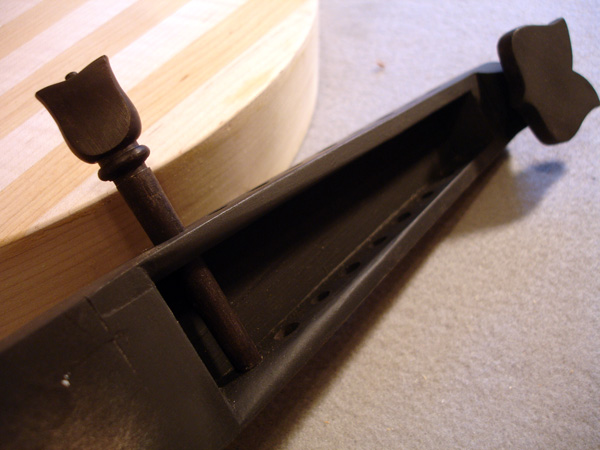
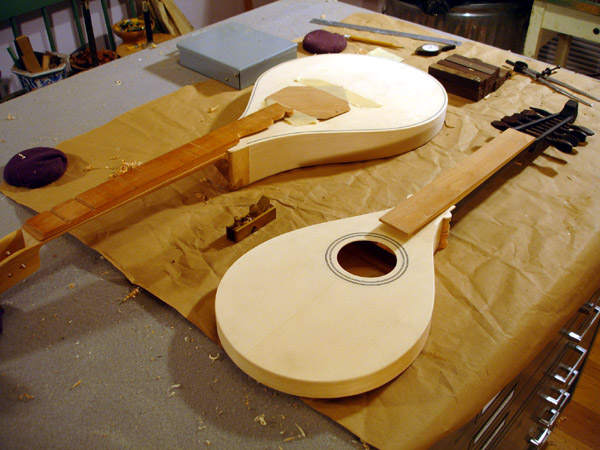
The latest DaSalo has top attached and pegs turned and is awaiting fretting. The tenor is in progress of fretting (the fingerboards are unattached)
Here is my English backcut saw. What's wrong with that sentance? I give the English, especially of Sheffield, full credits for handsome saws and superior steel, but why anyone in the world is still making push saws since the Japanese arrived I do not understand. I pounded the blade out of the brass spine, reversed it, and then tapped holes for a depth gauge, et volia, my Japanglish fret saw. My beloved dozuki's blade is the right thickness for the tangs of modern fretwire, but I needed the beefier English Gent's Saw blade to match the brass stock I use for the DaSalo frets.
Following are finished images of a constructed neck cittern.
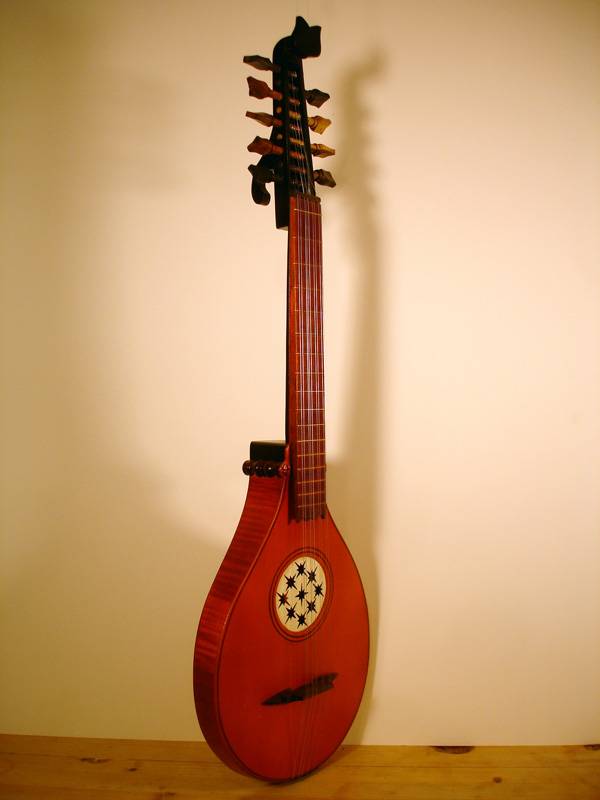
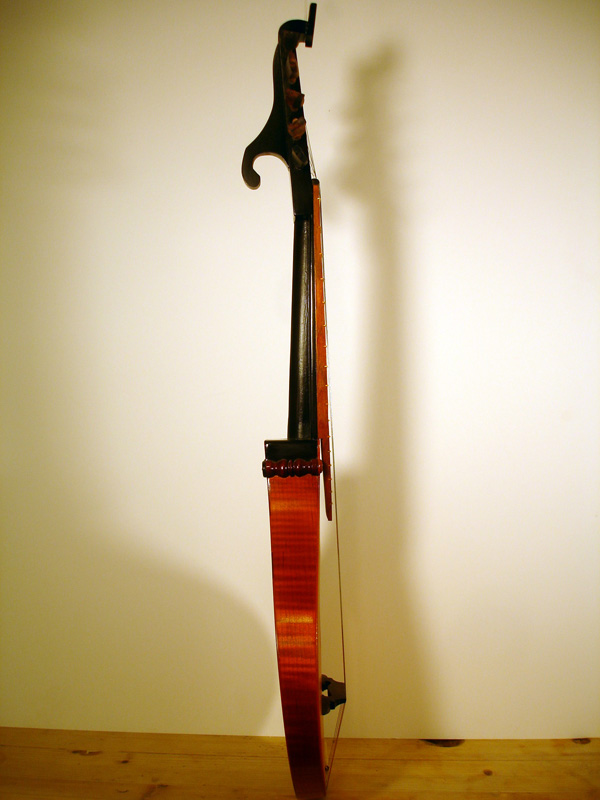
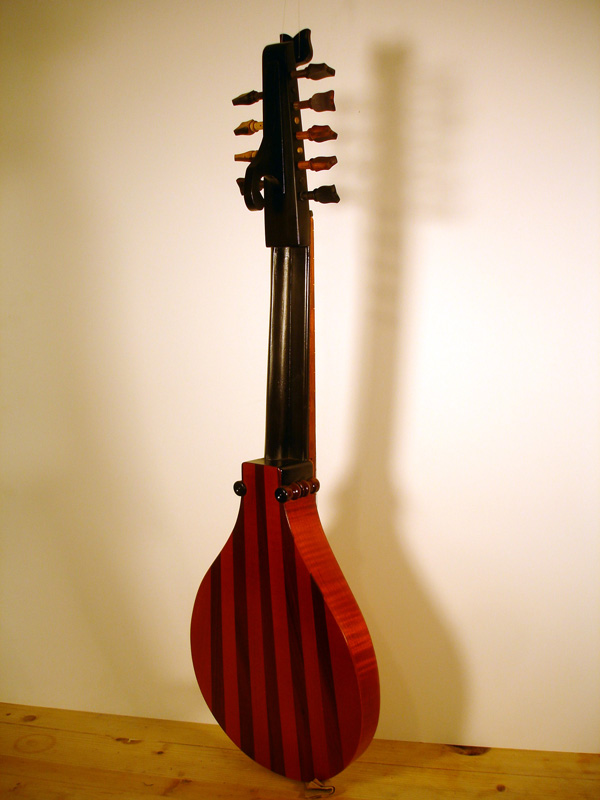
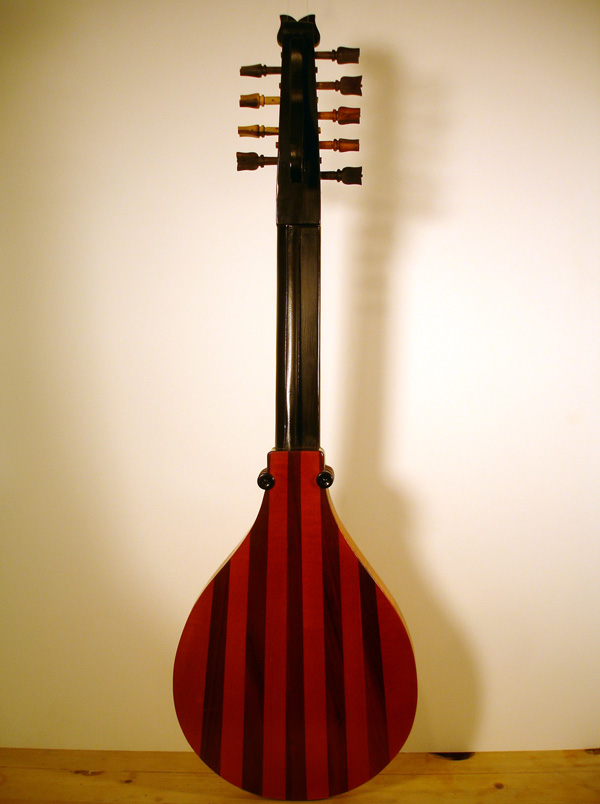
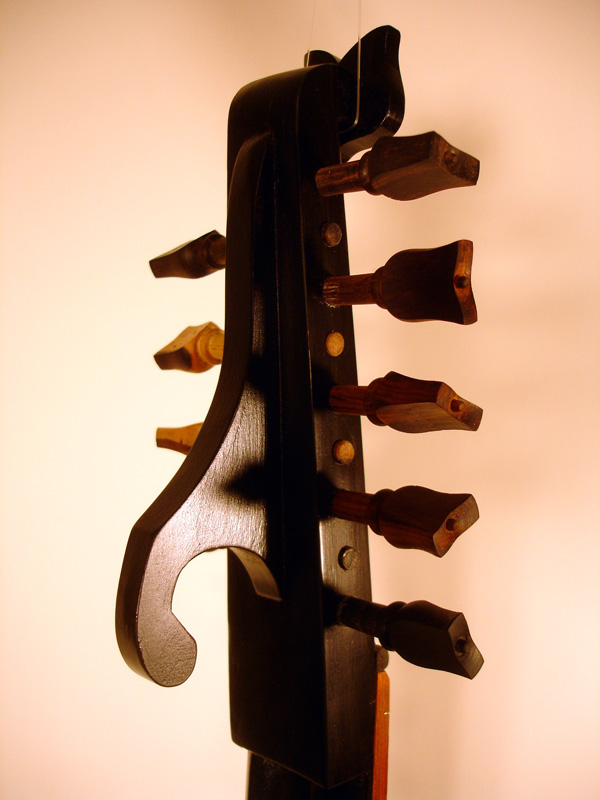
This particular instrument has a motley assortment of peg woods: rosewood, wormy rosewood, ebony.
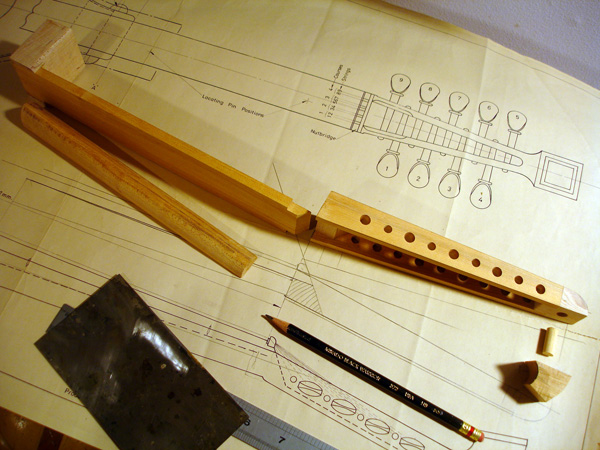
Showing the individual parts of the constructed pegbox before glueup.
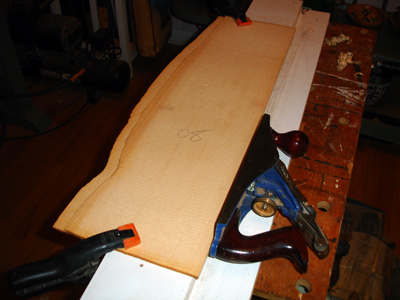
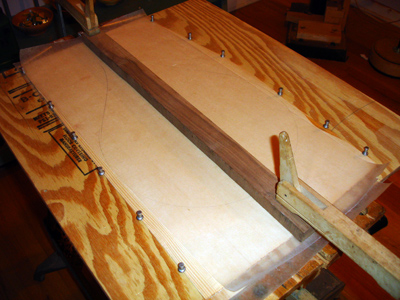
Shooting the soundboard and joining the soundboard for a Tenor.
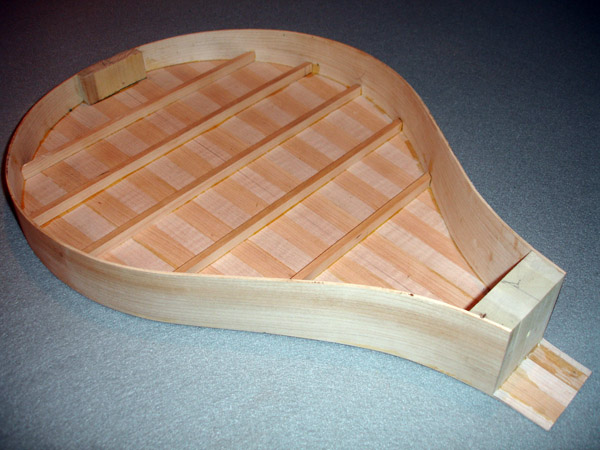
The back braces are in place of a Tenor. This particular instrument is intended for a high-tension tuning so I am employing a greater number of braces both for the top and back.
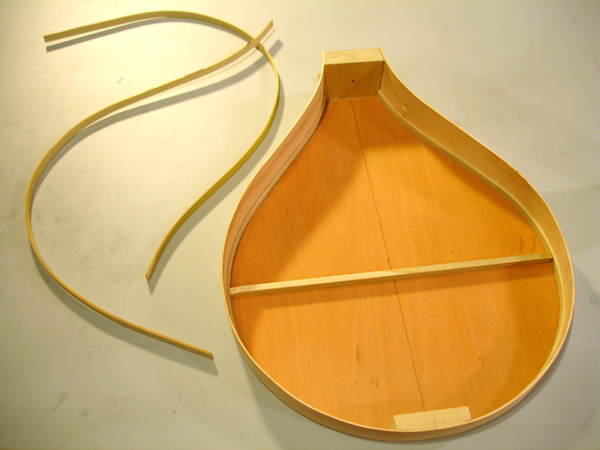
This shot of a more recent tenor cittern body shows my new improved back construction. Instead of lining each stave with cotten strips like a lute construction, or covering the inside back with braces as above, I am laminating a piece of veneer on the inside and using just one limewood brace to keep the back from caving. It's lighter and stronger. No chance of the staves seperating. The only sacrifice is seeing the veneer expressed on the outside of the rib, but. . .
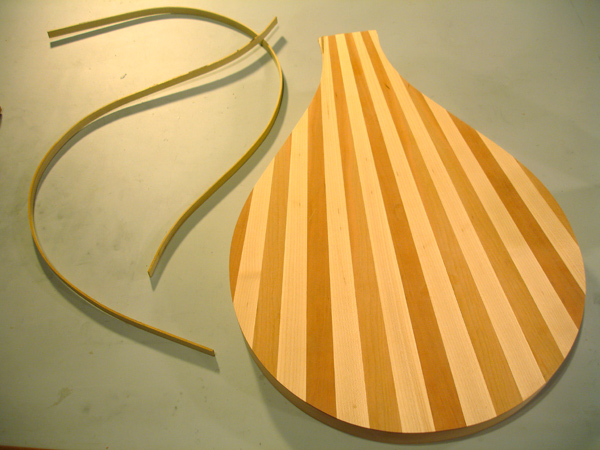
. . .putting a dark strip on the outside edges minimizes the effect. Limewood linings await attachment.
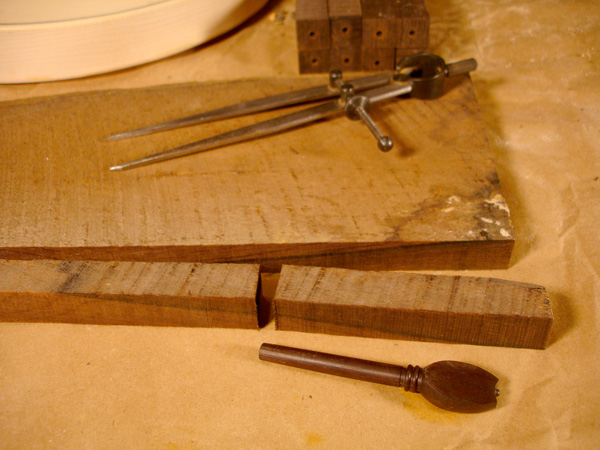
This is the peg shape I am gravitating towards, here in ebony. It's a simplification of the Ashmolean DaSalo shape.
.jpg)
Rough shaping the thumb channel can be done with the router, I have decided. I'm getting some milage out of the painstakingly-made slit drum tuning slot templates. It's just a hair short as you can see.
.jpg)
Et volia.
.jpg)
Carving the profile against the heel of the pegbox
.jpg)
After the profile is made on both ends the bulk can be removed with the bullnose plane.
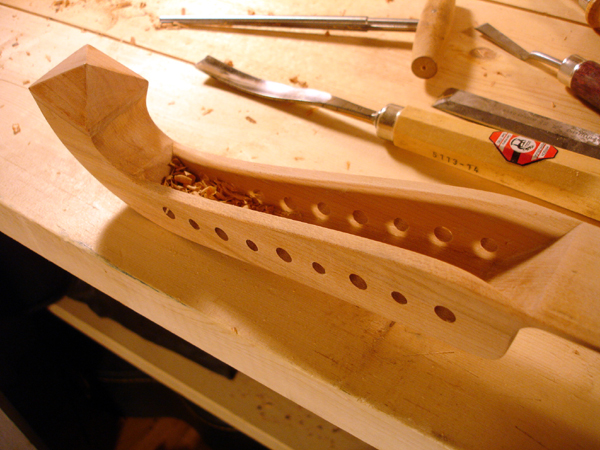
Final carving of the inside of the pegbox
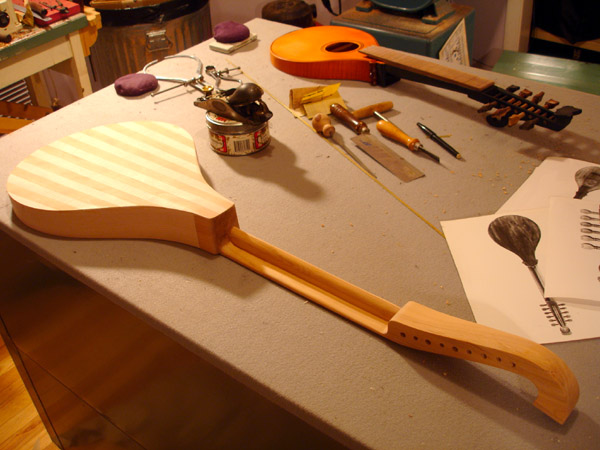
General view of the work, finish on the constructed neck DaSalo in progress, neck/pegbox attached to the tenor.
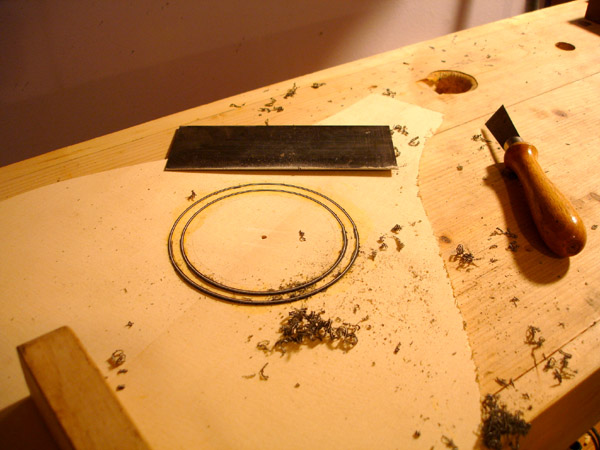
The double rosette purfling of the tenor being trimmed
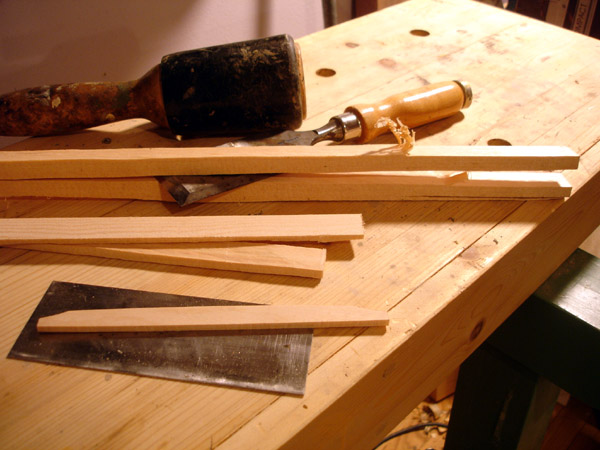
Splitting and planing Sitka spruce for the tenor braces.
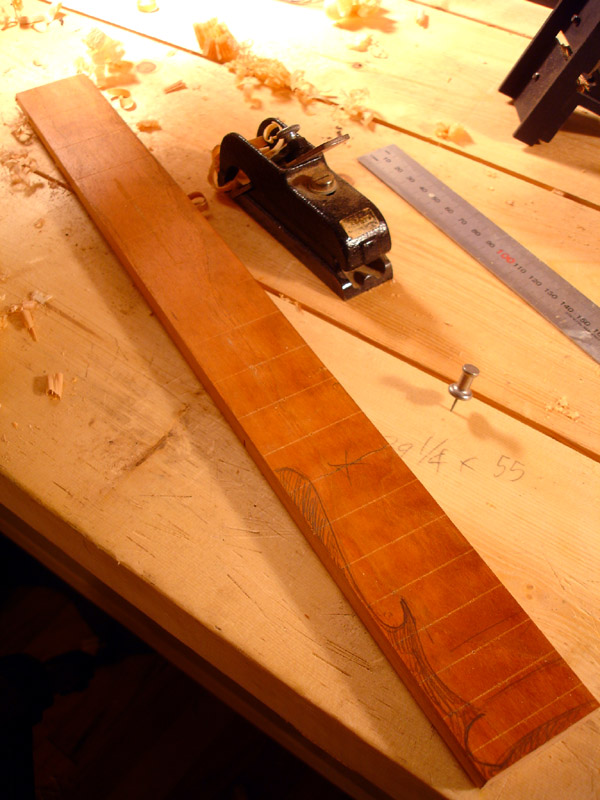
The Tenor fingerboard. The profile is my own shape based on a mid-17th c. Dutch instrument.
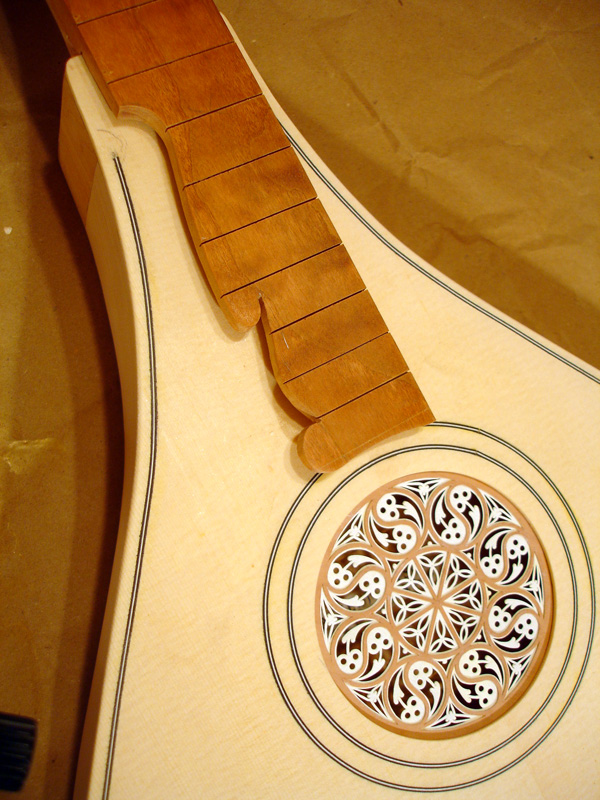
The fingerboard profile is cut, the leading slot for the fret wedges are cut, the top is attached with the rosette in place. The rosette on this instruemnt is the work of Elena Del Cortivo of Milan. Thanks to the miracle of the internet a Georgia luthier can order a rosette from Milan. However this is the first instrument where I have ever incorporated the work of another - at the request of a customer who wanted a fancier rosette than I was prepared to undertake - and I am undecided about whether I want to allow this sort of thing to continue. I am all too ready to abandon the carved gothic rosettes of my earlier instruments in favor of some type of two-layer design like this, but I must settle on a desireable pattern and a reasonable way of producing it.
.JPG)
The lining is glued on. The top edge will be trimmed after the top brace is attached to the soundboard and the exact curve of contact can be determined. Also visible, the linen strips covering the stave seams.
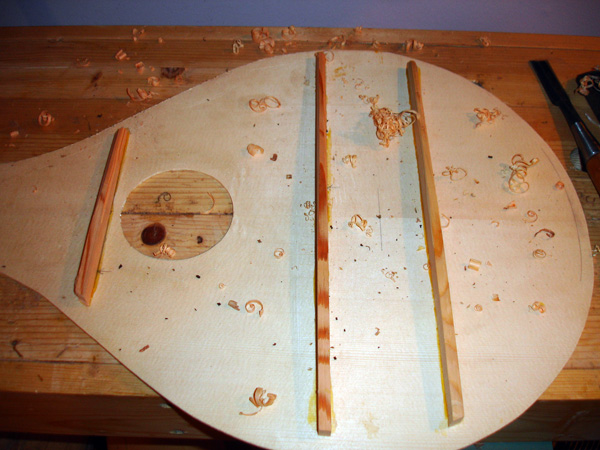
The top spars are glued on and are being shaped. The bridge location is located with a pencil mark. This was an experiment with turning the brace grain direction.
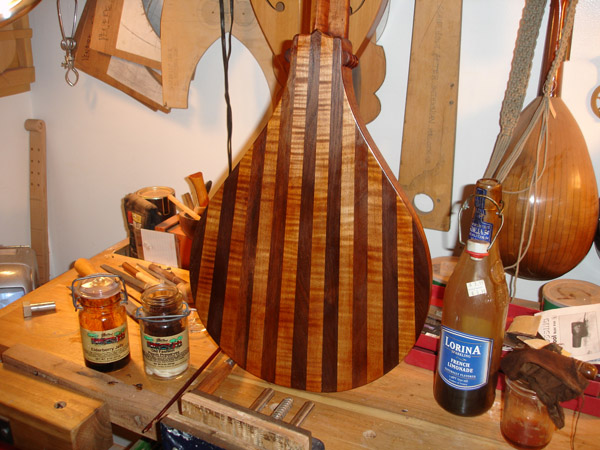
French polishing. This instrument will have an aged appearance.
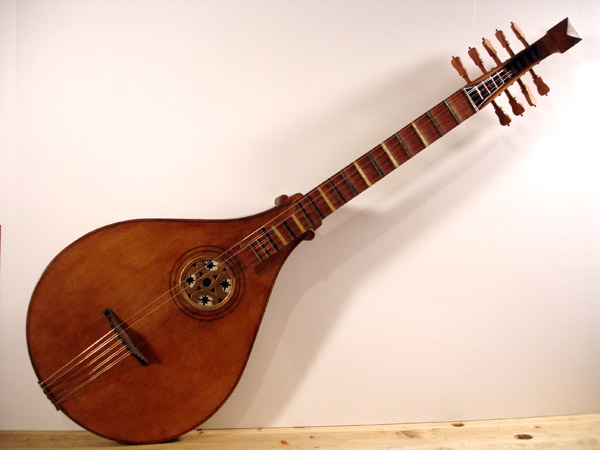
An
instrument with a not-at-all historical rosette but showing these pictures
for the 'antiqued' french polish finish
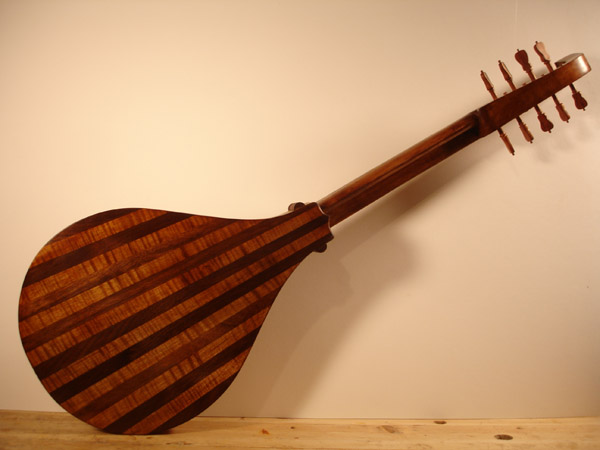
Following are some images related to the cittern fittings: making the boxwood and ebony fretboard wedges, the pegs, scrolls, pyramid pegbox head cap.
.JPG)
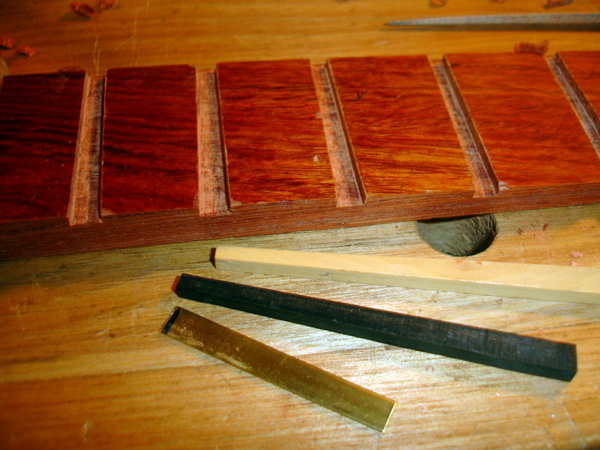
.JPG)
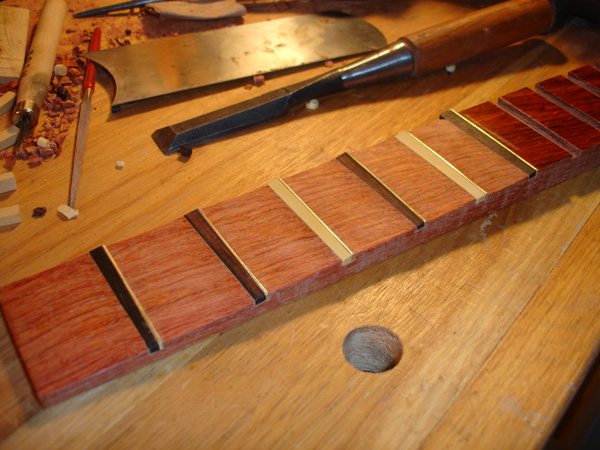
The
piece of Jatoba I'm using for the fingerboard started life as a flooring
sample (from my architectural firm) and I've found the laquer topcoat
to be a great measure for exactly how much wood to take away when carving
the scallop. When the last piece of laquer is gone, the height just in
front and behind the fret slot is just right.
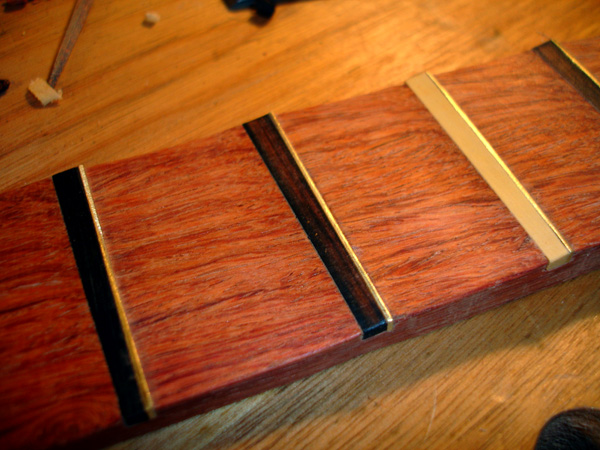
I have seen some makers - they have been modern reproductions - make the wedge not only tapered but with an undercut dovetail thus taking extra measure not to have the piece fall out. One maker infact used no glue and relied entirely on friction. I am gluing these frets in place so am not taking this extra measure.
Here is visible the scribe line I use to set a consitant depth for my first chisel strike on both sides of the fingerboard. Cherry fingerboard for a tenor.
After striking each end of the slot it is easily cleaned out with a chisel I have specially ground to the shape of the wedge taper.
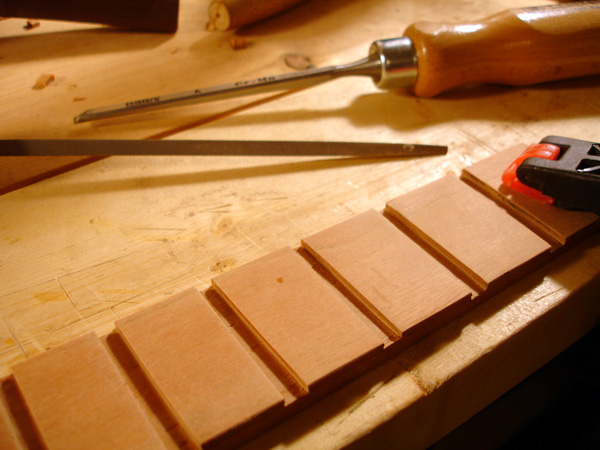
The finished slots are ready for the fitting of the wedges.
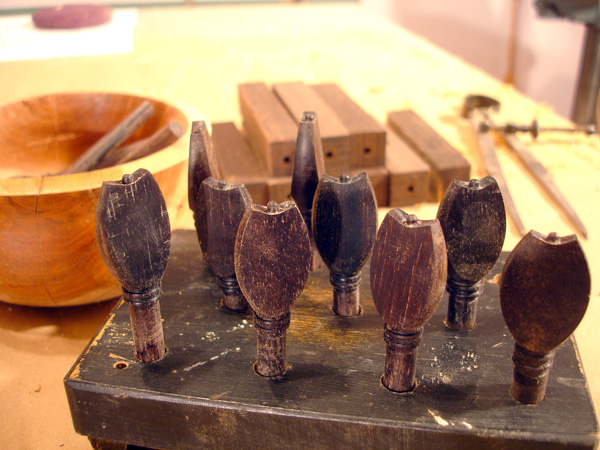
Here is the latest crop of DaSalo pegs. This shape is very close to what is currently on the Ashmolean instrument, however I suspect that the pegs, like the fingerboard, are contrivances of the Hills. They are in too pristine a condition and a little too "Renaissance". These are more endearing when they are clean.
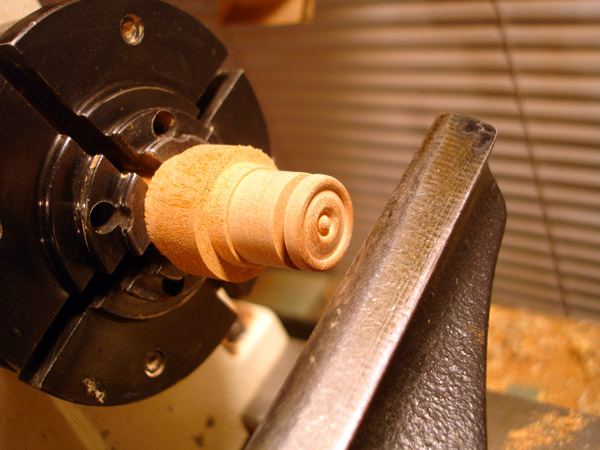
Turning a scroll cover
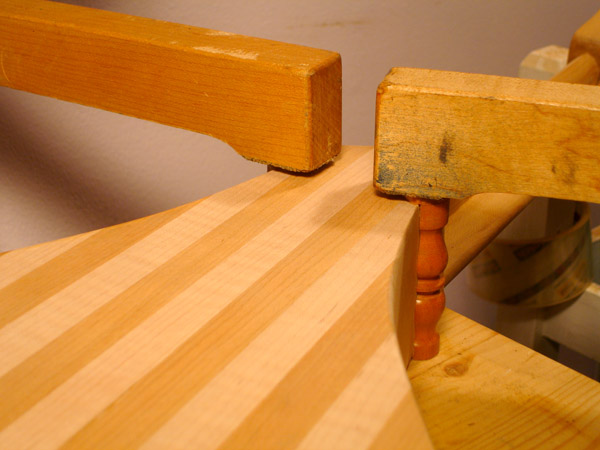
Attaching the scroll covers
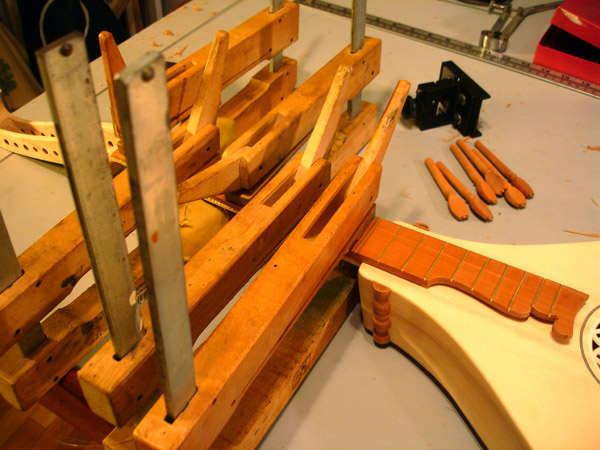
Attaching the fingerboard of the tenor cittern.
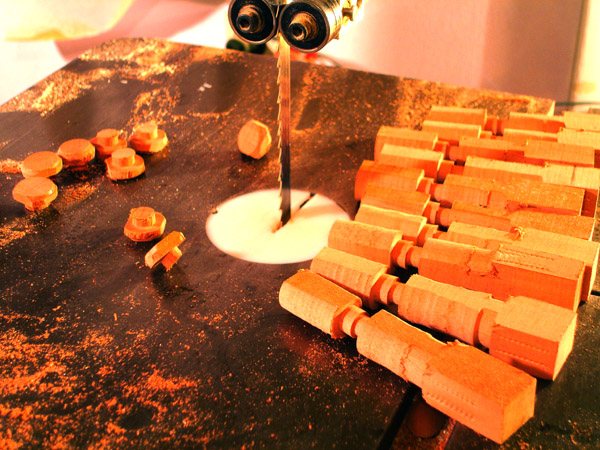
Pegs in the making for the tenor cittern. I've learned to avoid tailstock pressure whenever possible. So I rough turn only between centers then cut the top waste off to hold the head end in a chuck while I turn the shaft, then flip it around to turn the head. Complicated, but less split pegs.
Where cittern fretboards come from: a block of Swiss Pearwood.
I've finally made a little miter box for my fretwork.
The tenor cittern has the top on and the fretgoard is resting in place, fretting in progress.
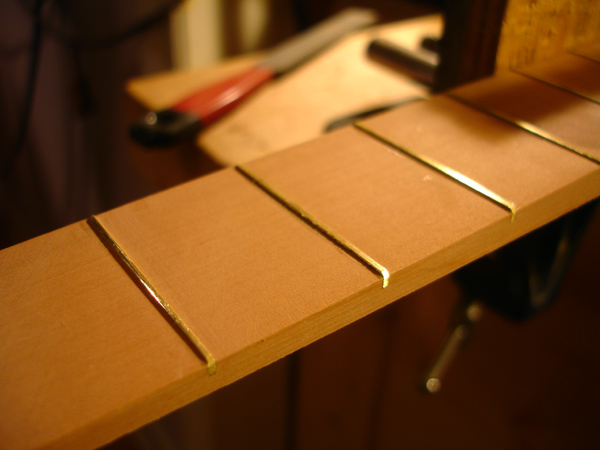
Fret dressing on the cittern in progress. The nearest fret is finished with a domed polish. The next frets still have a bur from leveling. On citterns, the lower the fret , the better the intonation. Especially when the fingerboard is not scalloped.
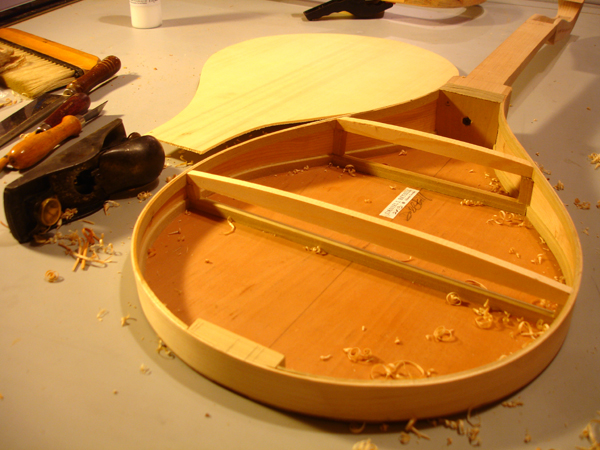
The table spars are attached to the tenor cittern. This is the highest tension I have put on one of these instruments: an octave mandolin tuning in 5ths, so these are some beefy bars.
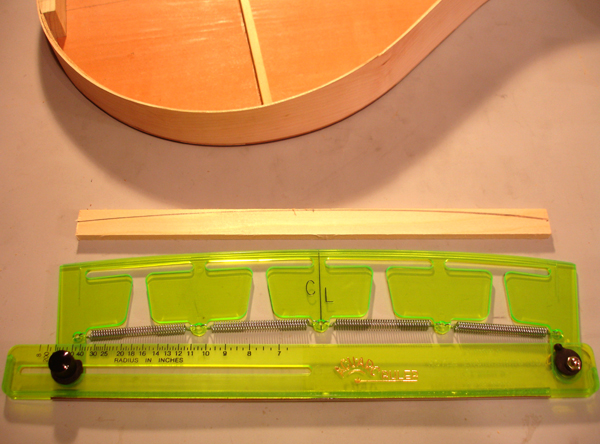
I bought this tool to draw entasis on column shafts for my day job. But it works great for cittern brace arch drawing too
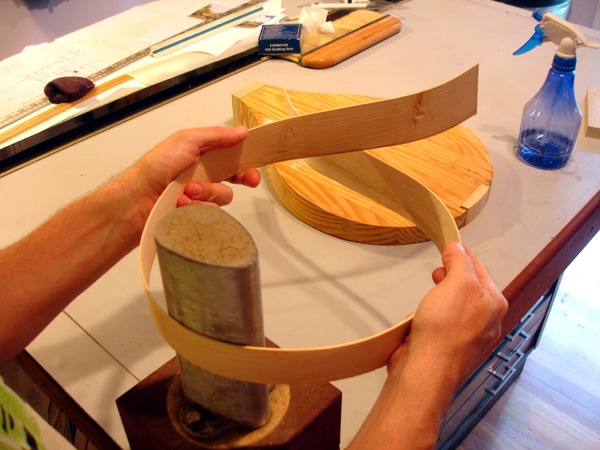
Don't cross the streams, Ray! ! ! On a cittern it's possible to have a continuous rib rather than two that's typical on a guitar. The disadvantage is you wind up having to warp it in the process. Which then gets creativly corrected. Venkman, shorten your stream, I don't want my face burned off.
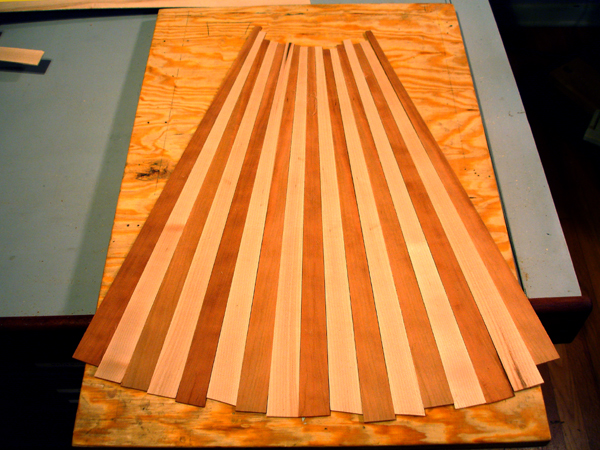
Laying up the cherry and maple staves of the back of the tenor cittern.
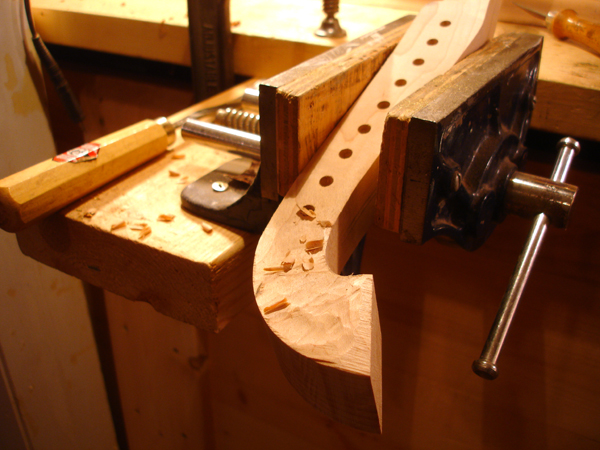
Work on a new tenor cittern commences. I'm making the neck shorter on this one for an octave mandolin tuning.
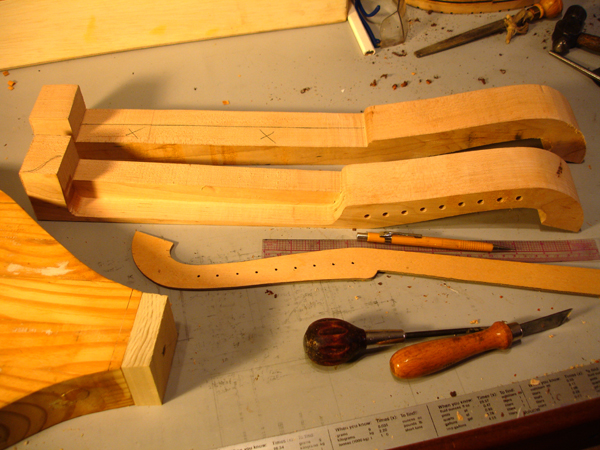
My 'Standard' 61.6cm mensur tenor cittern (top) compared with the shorter version for an octave mandolin tuning
+++++
A More Delicate Cittern
Following are some project log images of a standard da Salo which I am endoving to make as light as possible, not just weight-wise but visually.
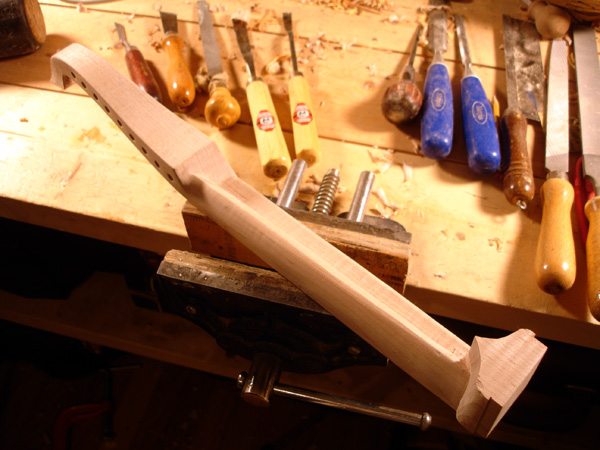
The neck has a very slender pegbox and the heel has a mimum of material.
.jpg)
The outside shaped, I am carving out the interior.
.jpg)
.jpg)
The rib is of perfectly quartersawn hard maple of a thickness slightly less than 2mm. I have rough shaped it prior to bending. Note the block of the body has been drilled out, removing weighty material that contibutes noting to the instrument structurally.
.jpg)
The rib being glued to the blocks with form in place.
.jpg)
The pieces for the back are being glued up. The lightness of this instrument will be reinforced by the color and simplicity of the materials. I have decided to use pearwood for the secondary wood and fittings. Using the same wood for the back stripes, fingerboard, pegs, etc, will keep the color scheme visually simple, and the value of the Swiss pearwood is not so much of a 'heavy' contrast that would result from ebony or rosewood.
.jpg)
The neck is fully carved and temporarily attached to the rib and the back is rough cut, It is so thin - less than 2mm thick - that I will veneer a cross-grain flitch of pearwood veneer to ensure the pieces will not come apart. This is a lighter method than populating the back with many cross braces. Only a couple of thin crossbraces will be needed to prevent back deflection.
.jpg)
The linings are on and the rib is attached to the neck
.jpg)
The veneer is applied
.jpg)
The back is attached to the rib
.jpg)
The back is on and trimmed
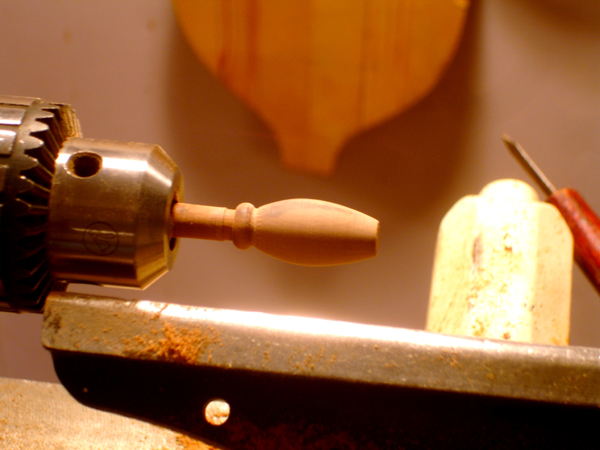
The rough shape of the peg, in pearwood.
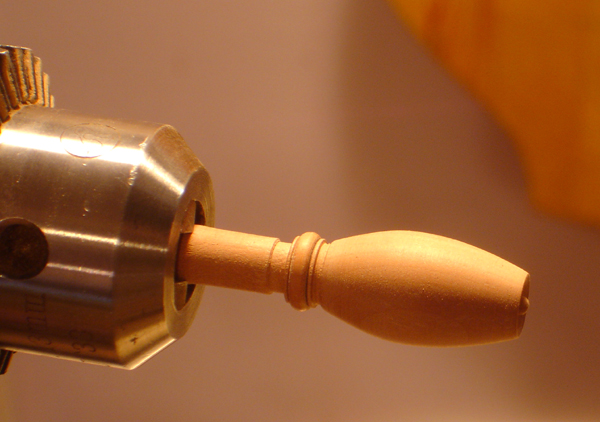
Refined. . .
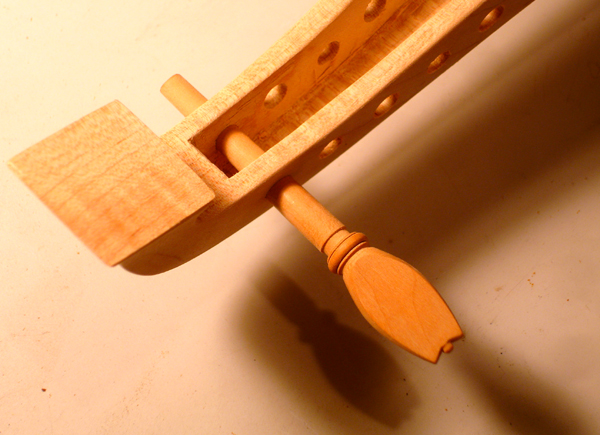
Finished peg.
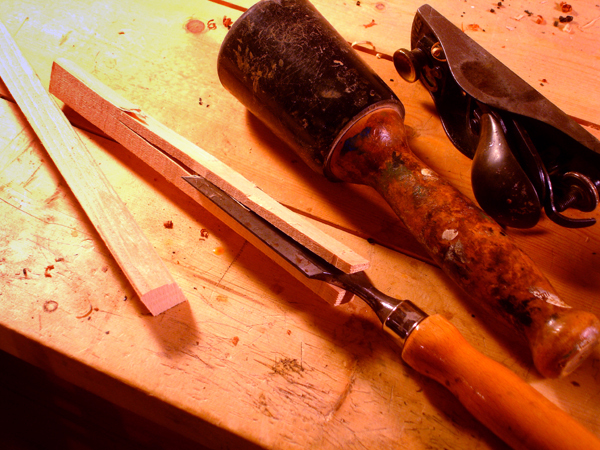
Splitting the table spars.
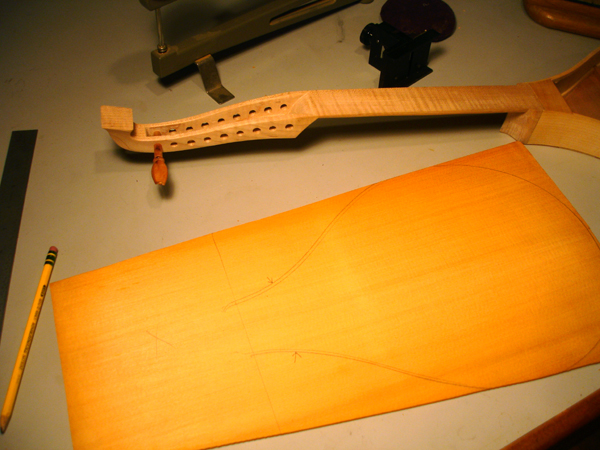
The yellow edges of this sitka spruce soundboard tell a story. I got this with a cache of other soundboards from Vancouver lutemaker Grant Tomlinson back in 1999. He threw a few of these pre-joined tops in my order 'for free', I presume because they were too small for his intruments and he knew I was in the cittern business. He couldn't remember exactly but he thought they had been prepared for Renaissance guitars. He mentioned he had had them for at least 20 years. So they're well seasoned by now!
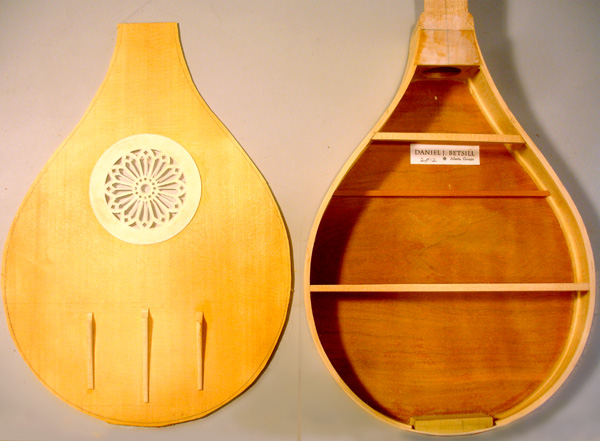
Showing the barring for this instrument. The bar just above the bridge location is stacking with a back spar. The upper back spar centers on the rose location. Due to the thinness of the top, a uniform 2mm, I am adding vertical splints behind the bridge. This top is designed to bend laterally, as with any renaissance cittern, but also crown slightly longitudinally to maintain tension on the top. and help prevent it from collapsing at any point.
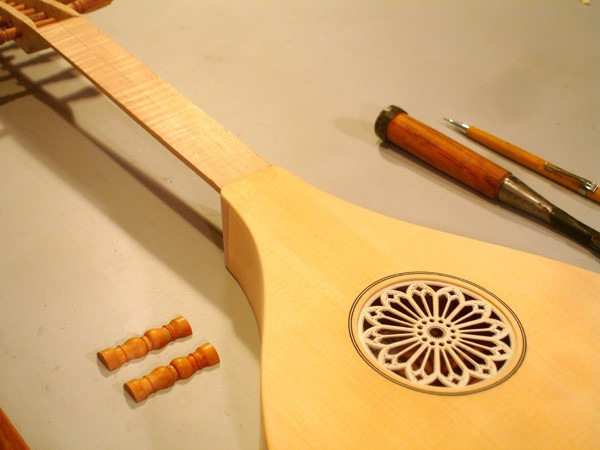
The rose for this instrument was supplied by a local lute player who has branched into rosette making and based this design on the rose window at the Duomo. The split posts are ready to be glued on.
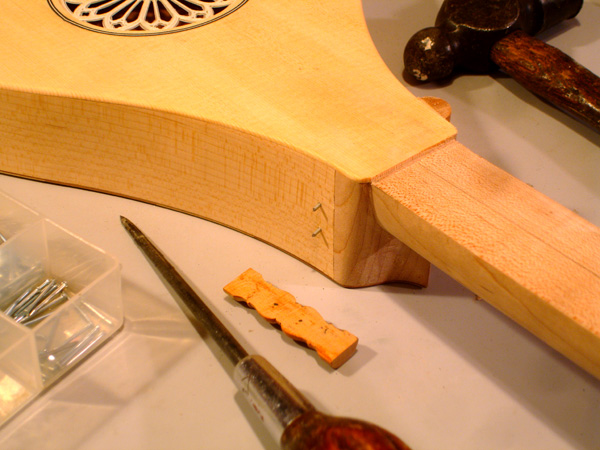
Wire brads with the heads cut off are extra security for attaching the scrolls
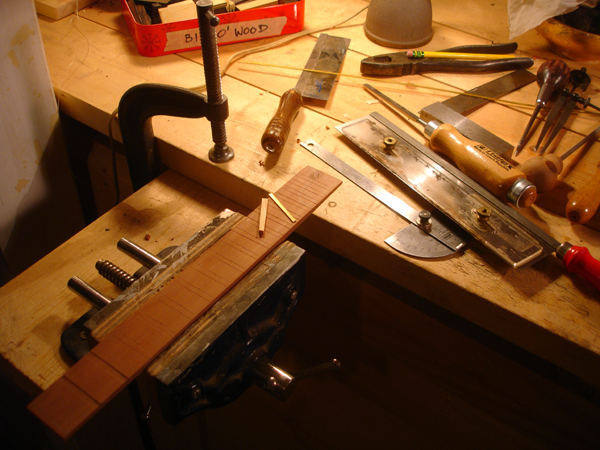
Cutting the slots for the frets.
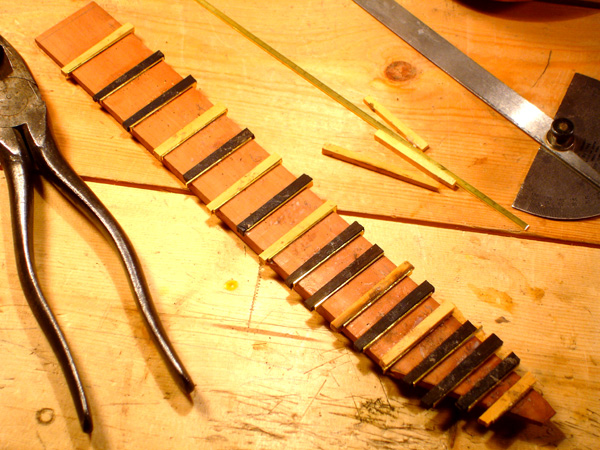
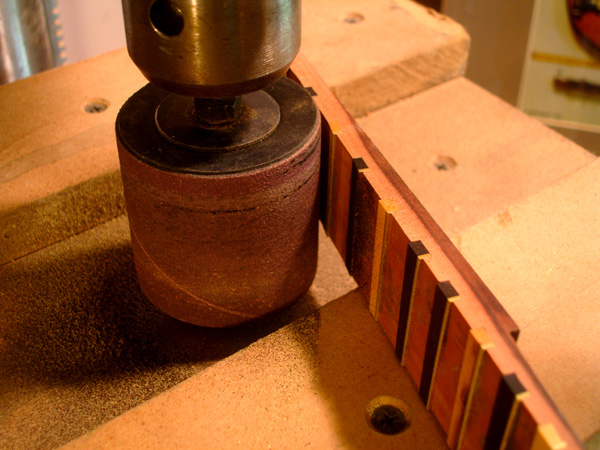
Gluing in place the fret wedges and drum sanding the fretboard scallops
more to come. . .
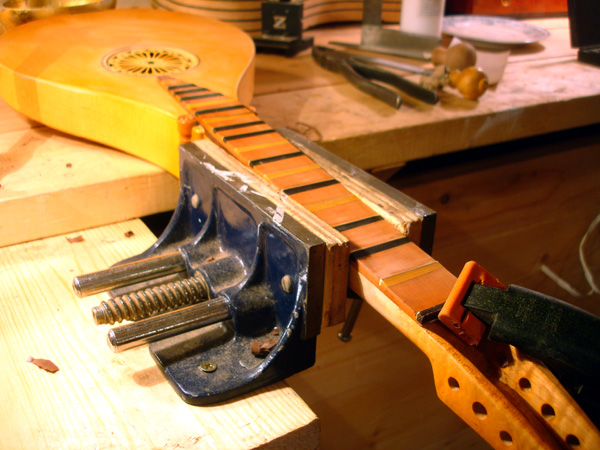
Attaching the nut. The instrument is finished in a tinted french polish with thin protective coat of wax.
Completed pictures
.jpg)
.jpg)
.jpg)
.jpg)
.jpg)
.jpg)
.jpg)
.jpg)
.jpg)
.jpg)
.jpg)
Rosette by Steven Winiarski of Atlanta, styled after the rose window of the Duomo, Florence.
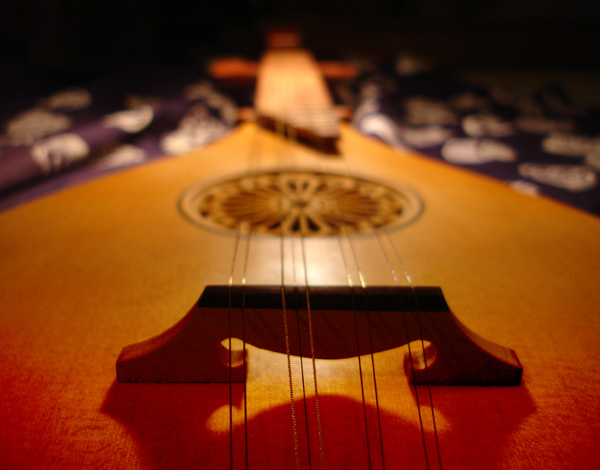
Arty shot #1
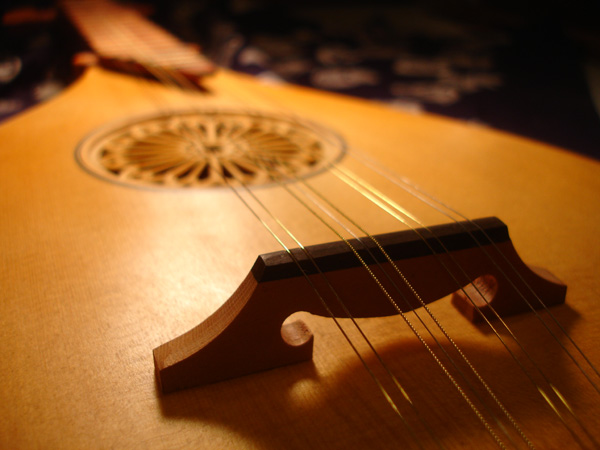
Arty shot #2
Link to video of me playing this instrument. Still working on my Mark Cudek "cluck".
+++++
Research
I have crossed paths with many citterns over the years, both antique in collections and modern reproductions. Each time I meet a new instrument I take notes, and hopefully, pictures and a tracing. However with out a doubt the finest specimen I have been in the same room with is the DaSalo in the Ashmolean Museum, Oxford. Following are excerpts from my study photographs of this instrument.
The study area: the Map and Print Room, where photography with a flash and tripod is prohibited. I found that out only after I had lugged my tripod through many train stations. I also was breaking in a new digital camera which did not function well in low light: this explaining the poor quality of many of the images. It was the experience that counts.
The end pins which look suspiciously like modern brass tacks. Perhaps a substitution of the Hills? We know this is not the original stringing.
The master's stamp
Despite their draconian restrictions on tripod use, I must say that they were terribly accommodating in providing me with this Hill collection catalog to serve as my backdrop.
Here ends the Leffon.
+++++
Right honorable and thrise noble Lord: (the sole true patron of all vertue and my poore deservings) I have long wrastled in the labor of my best wits, to betoken to your L. selfe as the choise of a world, some acceptable pledge or testimoniall acknowledgement of my love, duety and thankefulnes: which in the best allowaunce from my weake fortunes I can in no sort better appoint then by this my silly Citharn Schoole.
-Anthony Holborne,from the Citharn Schoole
Gentlemen, blame me not although I have beene so long cracking of this nutte, fith as last I have given you the sweetest Cornell of my conceited Cithering.
-Thomas Robinson
The twelfth Rule. Note, that you keepe alwayes your hands cleane, and your nailes short.
-Thomas Robinson
With my strings of small wire lo I come, And a cittern made of wood; And a song altho' you are Deaf and Dumb. May be heard and understood dumb, dumb. . .
-D'Urfey, Don Quixote
Barbers shall wear thee on their citterns and hucksters set thee out in gingerbread.
-Forde, The Lover's Melancholy
